
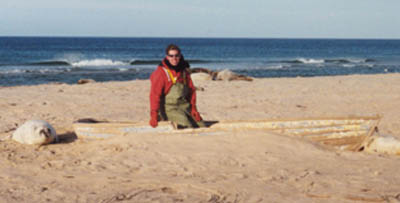
Biology Department
Dalhousie University
Halifax, NS
B3H
4J1
Tel: (902) 494-3723
t m s c h u l z @ d a l . c a
|
The Structure and Function of Sperm whale (Physeter macrocephalus)
coda sequences
I am currently a Ph.D. student in the lab of
Dr. Hal
Whitehead. I am studying the structure and function of coda communication in
the sperm whale, an incredible animal of extremes. They are the largest
odontocete (toothed whale), they have the largest brain of any animal, they are
cosmopolitan in their distribution, they are highly social, and the take of
oceanic prey by the world's population of sperm whales approaches that of all of
the human fisheries combined! Sperm whales appear to communicate by using codas.
Codas are discrete, stereotyped patterns of broadband clicks, generated by
groups of sperm whales while socializing at the water's surface. Previous
recording methods have limited analyses to the use of codas by particular
groups, rather than specific individuals within the groups. This is because it
is difficult to determine which animal made which vocalizations. To correct for
this problem, I will be using an acoustic array to localize sperm whale
vocalizations. In so doing, I will be able to determine the identity of the
vocalizing whale within a recording session, thereby permitting the analysis of
sequences of codas. This research will fill a gap in our current knowledge and
allow us to determine the function of coda sequences in the social structure of
this remarkable species.
The dynamic acoustic array will be created by
positioning hydrophones around a sperm whale group. The hydrophones will be
carried by Remotely-Piloted Vessels (RPVs) which are pictured below.
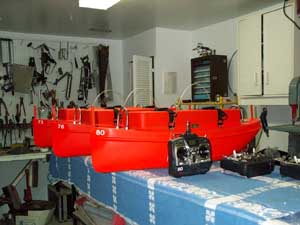 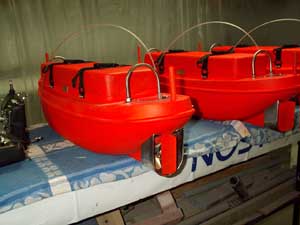
Check out pictures from recent field work in the Sargasso Sea.
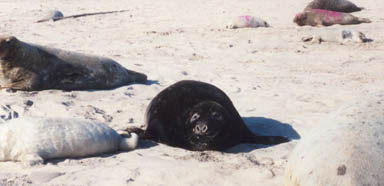
The Evolution of Lactation Strategies in PinnipedsI conducted my
Masters thesis at Dalhousie University under the supervision of Dr. Don Bowen
and in the lab of Dr. Sara Iverson . I looked at
adaptive relationships between maternal and offspring life-history traits in
pinnipeds. In the suborder Pinnipedia, there are three general lactation
strategies; the aquatic nursing strategy involves the offspring accompanying the
mother into the ocean while she forages during lactation. In contrast, the
foraging-cycle strategy involves the mother alternating periods of suckling her
pup on shore with periods of foraging in the ocean. Lastly, in the fasting
strategy, the mother remains with her pup on the breeding substrate for the
lactation period, abstaining from foraging and relying on her own fat reserves.
In my project, I looked at the influence of body size, latitude of the breeding
colony, breeding substrate, and evolutionary history on the length of lactation,
lactation strategy, and other life-history traits. I used a phylogenetic method
to ensure that significant correlations between variables were a result of
adaptive relationships and not simply a consequence of the fact that more
closely related species are more phenotypically similar.
Go to my page on the
Iverson lab homepage
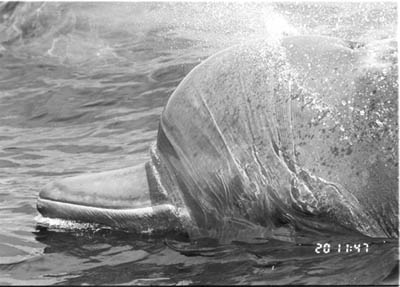
Sailing in the Sable GullyAs part of the research of another master's
student in the lab, Tonya
Wimmer , I sailed on Balaena for three weeks around the Sable Gully
and the two nearby canyons looking for nothern bottlenose whales

Field Research on Sable IslandWhile working on my Masters thesis, I
assisted with grey seal field work on Sable Island. During my last field trip, I
teamed up with Damian Lidgard to monitor the birthing and weaning of the pups of
key study animals. This involved circuiting the island every day on ATVs,
checking for weaned pups and weighing weaners. Subsequently, pups were collected
for branding. As part of my field work on Sable, I also assisted in deploying
TDRs and stomach temperature monitors as part of the Ph.D. project of
Debbie
Austin
Publications and Presentations
Schulz, T.M. and Bowen, W.D. (In press). The evolution of pinniped lactation
strategies: A phylogenetic analysis. Ecological Monographs.
Schulz, T.M. and Bowen, W.D. (2004) Pinniped lactation strategies: Evaluation
of data on maternal and offspring life-history traits. Marine Mammal Science
20(1):86-114.
Schulz, T.M. (2001) The evolution of lactation strategies in pinnipeds: A
phylogenetic analysis. Masters Thesis. Dalhousie University, Halifax.
Schulz, T.M. (1999). Freeze tolerance and amino acid changes in response to
temperature in the quahog (Mercenaria mercenaria) and American oyster
(Crassostrea virginica). Honours Thesis. Universtiy of Guelph.
2001 Schulz, T.M. and Bowen, W.D. The evolution of lactation strategies in
pinnipeds: A phylogenetic analysis. 14th Biennial Conference on the Biology of
Marine Mammals. Vancouver, British Columbia.
Top
of the Page


Dalhousie University Home
Page
Behavioural Ecology Tutorial Marks
| This page was designed by Tyler
Schulz
Created: May 12, 2003
Last Updated: January 9, 2006
|








